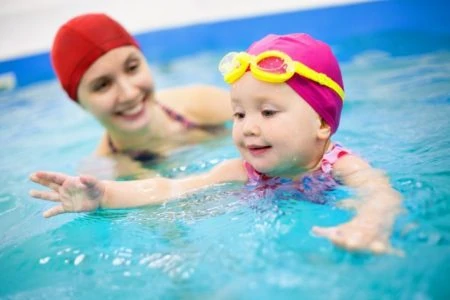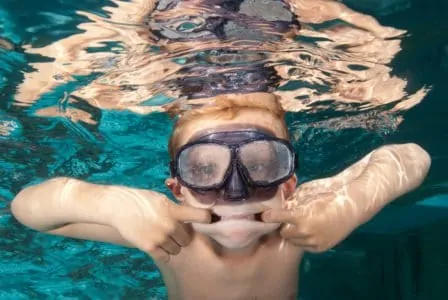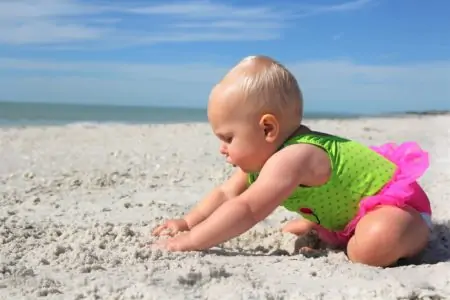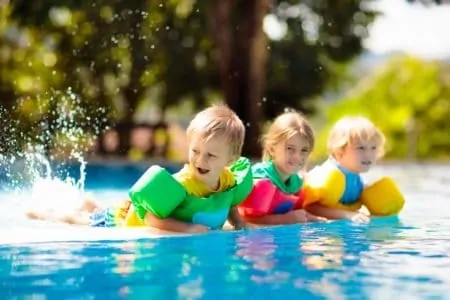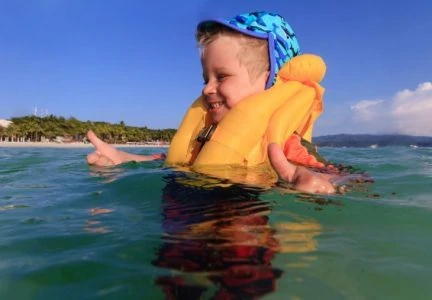Do you wonder what you can do to prevent your child from drowning?
Water safety, especially for young children, is a real issue you should be concerned about as a parent.
There are about ten deaths from drowning in the United States every day. One in five of those people are children who are under the age of 14.
That’s not even counting the people who die from drowning in boating accidents every year. (1) Many other children who don’t die from drowning suffer other injuries in the water, like brain damage from lack of oxygen.
But as they say, prevention is the best cure. Armed with the right information, we can all sleep a little easier at night.
This is everything you should know about swim safety for kids.
Child Drowning Statistics

Knowing how often something happens can let you know how big of a risk it is to you and your family.
360,000 Drowning Deaths Per Year
Certain countries have far higher drowning rates than other countries do. Mozambique is the country with the highest drowning rate (3). By comparison, the United States places 138th in the list of drowning rates by country.
Drowning rates are highest for children ages 1 to 4, and the second most common age group to die from drowning is the group of age 5 to 9. That’s terrifying to parents like me who have children in those age categories.
To give parents an added reason to worry, drowning rates are highest for children ages 1 to 4, and the second most common age group to die from drowning is the group of age 5 to 9. That’s terrifying to parents like me who have children in those age categories. Being a parent means worrying about every threat — real or perceived — all the time. It’s hard to fathom a fun day of swimming at the local pool turning into the last day of your child’s life, but for many people, that nightmare becomes a reality.
Drowning Can Happen Anywhere
Warmer months are a heightened time for potential drownings simply because more people are in the water to beat the heat.
Here are some of the risk factors for drowning:
- Age: Young children are most likely to drown.
- Gender: Being male makes someone more likely to drown, perhaps because of risky behavior or drinking alcohol.
- Being around water: Living near water that isn’t fenced off increases the risk of drowning for small children.
- Floods: Living in areas that are at an increased risk of flooding gives children a greater chance of drowning.
- Commuting on water: If you travel by water, you have a greater risk of drowning.
- Minorities and having less money: Children who are minorities and who come from families with less education and lower economic status have an increased risk of drowning.
The Signs of Drowning

Adults may be on the lookout for a child who is waving for help to indicate they are in trouble. But kids who are drowning are already instinctively using their arms in an attempt to keep their head above water. They can’t wave for help — they are in a fight for their lives.
The signs of drowning aren’t obvious at all. And that’s what makes them especially scary to a parent.
It can literally take just a few seconds of an adult not paying attention to a kid in the water for a drowning to occur. And if it is happening right before your eyes, you might not even realize what’s going on until it’s too late. Up to half of all kids who drown are less than 25 yards away from an adult when the drowning occurs (4).
Can't Call For Help
While many people assume children who are drowning will be loud and drawing attention to themselves, that’s not often the case. Often kids won’t even seem like anything is wrong to the casual observer. You may just notice the kid is looking up (5).
Here are the major signs a child may be drowning, and they may be dramatically different than what you expect.
- There will be no call for help: If you can’t breathe, you can’t speak or yell.
- You may see their mouths sinking and bobbing back up repeatedly: If you see bobbing going on, you should check on the kid who is doing it. He could be in distress and you might be missing the signs.
- They won’t be waving for help: Their instinct is to use their hands to pull their mouths out of the water so they can breathe, not wave for help.
- They won’t be able to help their rescuer: They won’t be able to call attention to themselves, grab onto rescue equipment or reach out for a lifeguard.
- They are upright in the water and may not be kicking: If you see a child who is upright and not kicking, along with any of these other signs, get to them as soon as possible.
- The incident happens quickly: A person who is drowning doesn’t have much time — they can only struggle for 20 to 60 seconds before they go under.
- A child isn’t making any noise: As every parent can tell you, children who are playing in the water make a lot of noise. If your child can’t be heard anymore when she’s playing in the water, assume something is wrong.
Drowning Signs Checklist

- Their mouth or head is at the same level as the water.
- Their mouth is open, and their head is back.
- Eyes can’t focus.
- Eyes are shut.
- Hair is covering the face, forehead, or eyes.
- Gasping.
- It looks like they are trying to climb an imaginary ladder.
- They may try to assume the position of a back float.
Tips to Prevent Drowning

Even if there aren’t many kids in the pool, it’s up to us adults to be vigilant the whole time our kids are in the water.
Here are some ways you can ensure your child’s safety in the water.
- Make sure to supervise: No one cares more about your child’s safety than you do. You’ll be your child’s best watchdog when he’s in the pool because you are totally devoted to his safety.
- Keep your eyes on your child: When you’re supervising your children in the water, you should concentrate 100 percent on that task. This isn’t the time to play Candy Crush or have a deep conversation with other parents who are watching their kids. You need to keep distractions at a minimum.
- Lifeguards are your best bet: Lifeguards are trained to recognize the signs of drowning and they’ll likely spot any problems before any other adults will. Plus, they’ll have the training to quickly reach that kid and bring them to safety. Choose to swim at pools that have lifeguards on staff.
- Keep your little kids right by you: Kids under the age of 5 should be right by you in water, not several feet away. By making sure you’re within reach of your child, you can avoid the possibility of your child drowning.
- Don’t allow dunking: Kids like to dunk each other and sometimes parents even like to dunk their own kids. Dunking can be a dangerous situation because it can mask when someone really is in trouble.
- Be aware of medical conditions: If your child has medical conditions, like seizures, that make it dangerous for him to swim, he will need close supervision.
- Don’t let swimming toys give you a false sense of security: Just because your child has a swimming raft or a boogie board nearby, it doesn’t mean you can stop watching. It’s easy to fall off those pool toys or they can float away from your child when he most needs them.
- Be prepared for emergencies: If you have a backyard pool, you should always have a floatation device ready to throw to the person who is drowning. After you’ve thrown it to them, jump in the water and get to him as soon as possible to assist. Plus, a first aid kit is a great thing to have at the pool at all times too.
- Don’t drink alcohol: Drinking alcohol slows your reaction time. That means you might not recognize someone is drowning in time to do anything about it. Or, you’ll see it, but you won’t be much use to them because of your lack of coordination and how slowly you’ll be moving.
- Check on the weather conditions: This is especially important before swimming in the ocean or bigger lakes where the waters will be extremely choppy depending on the weather. You should also get out of the water if there are any thunderstorms around you.
- Avoid cramps: You shouldn’t eat a meal within an hour of swimming because you could get cramps that can lead to drowning. That’s also a good rule of thumb for children who have food allergies — most severe allergic reactions to food happen within an hour or two of eating (6). They don’t want to have a severe allergic reaction while they are in the water.
- Watch out for dangerous games: Kids, and adults for that matter, don’t always make the best choices. Be on the lookout for dangerous poolside activities like running on a slippery diving board, holding each other underwater, or diving into shallow water.
- Know CPR: Knowing CPR might be the difference between saving someone’s life and sitting there helpless while they die. It’s not difficult to learn so take the time to do so.
- Make your pool childproof: If you have a backyard pool, give some thought to child safety features.
Know the Rules of the Beach
When you’re going swimming at the beach, you have to be even more vigilant than you are at the pool. There are added dangers there like currents, waves, increased area for lifeguards to cover, and seaweed and other vegetation your child can get tangled in. Here are some tips for when you’re at the beach.
- Invest in the best life jacket for kids. That will give you some peace of mind.
- Know what the various safety warnings or flags mean.
- Talk to the lifeguard about water conditions that you should be aware of.
- Letting the waves nip at your feet is fun, but don’t let your child wade in too far without you. Those waves can drag them in if you aren’t careful.
Make Sure Your Children Are Aware of Safe Behaviors Around Water
Children, even very young children, are capable of understanding simple rules. You don’t want to overwhelm young children by adding too many complex rules — just stick with the basics.
- Don’t eat a big meal before you go swimming.
- No chewing gum while swimming. You don’t want to add the risk of choking into the mix.
- No swimming after dark. If people can’t see you, they can’t save you.
- Always swim with a buddy.
- Never act like you’re drowning just to get attention. It will stop people from knowing when you’re really in trouble.
- Only swim while an adult is watching.
- Make sure you drink water, even if you don’t feel thirsty after you’ve spent some time out in the sun.
- Always use sunscreen to avoid sunburns.
- Never swim during storms.
The rules for swimming in open water are different than those for swimming at pools. But these are crucial for children to learn as well.
- Make sure you never swim where the lifeguard can’t see you.
- Don’t swim out very far.
- Children should never swim alone.
- Keep away from piers.
- If you find yourself caught in a rip current, you should swim parallel to the shore instead of directly toward it. You may be able to get out of the current (7).
- Face the waves instead of swimming or walking away from them. Small children can be knocked over by waves as they walk back toward the shore.
- Use water shoes to protect a child’s feet.
- Make sure kids are always wearing lifejackets in open water.
Swimming Skills Every Child Should Know

There are certain skills that all kids will benefit from knowing. Some of these may seem extremely basic to you, but for a kid, it could be enough to save their life.
Child Swimming Basics
 Here are five things all kids should be able to do (8).
Here are five things all kids should be able to do (8).
- Tread water or float for at least 60 seconds.
- Turn in a circle and be able to locate an exit.
- Swim at least 25 yards before exiting the water.
- Pull themselves out of the water without using a ladder.
- Jump into the water until they are fully submerged and be able to get back to the surface.
Water Safety FAQs
Never Let Your Guard Down

Swimming is a great way to spend a hot day and it offers some of the best exercise you can get.
You should never be scared to head out for a day of swimming with your family.
Many families have some of their most memorable moments in the water, whether it’s been at the local pool or beaches while on vacation.
Just paying close attention to your surroundings and your children will be enough. Education is the key to staying safe.
